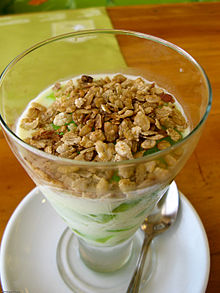Loading AI tools
Flattened rice ingredient in the Philippines From Wikipedia, the free encyclopedia
Pinipig is a flattened rice ingredient from the Philippines. It is made of immature grains of glutinous rice pounded until flat before being toasted. It is commonly used as toppings for various desserts in Filipino cuisine, but can also be eaten plain, made into cakes, or mixed with drinks and other dishes.[1][2][3]
 Pinipig toppings on buko pandan (a drink made from coconut meat, cream, and gulaman cubes flavored with pandan leaves) | |
| Place of origin | Philippines |
|---|---|
| Main ingredients | Glutinous rice |

Pinipig is made solely from glutinous rice (malagkit or "sticky" rice). The grains are harvested while still green. They are husked and the chaff is separated from the grain (traditionally using large flat winnowing baskets called bilao). The resulting bright green kernels are then pounded in large wooden mortars and pestles until flat. They are then toasted dry on pans or baked until crisp.[4][5]
Pinipig are characteristically light green in color when fresh, but usually become yellowish white to brown when toasted. They superficially resemble grains of oats, and are often confused with puffed rice. The texture is crunchy on the exterior with a chewy center.[5][6]

A notable regional variant of the pinipig is the duman, which is made in Santa Rita, Pampanga in the Philippines. Duman, like pinipig, is also made from immature grains of glutinous rice, but it is toasted before it is pounded.[7]
A similar delicacy also exists called cốm in Vietnam and Thailand.[6]
Seamless Wikipedia browsing. On steroids.
Every time you click a link to Wikipedia, Wiktionary or Wikiquote in your browser's search results, it will show the modern Wikiwand interface.
Wikiwand extension is a five stars, simple, with minimum permission required to keep your browsing private, safe and transparent.